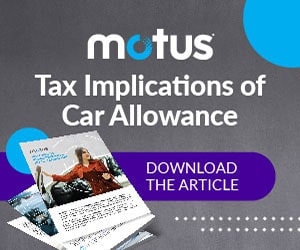Why a Car Allowance is Taxable
Across industries, car allowances have long been a favorite vehicle program. The reasoning is as simple as the program itself: a car allowance is easy to implement and upkeep. Which, for a company with hundreds of driving employees, or just a handful, may seem like the way to go. For all mobile workers, companies share a lump sum each month to cover the costs of business driving in their personal vehicles. In this blog, we will dive into what a car allowance is, what makes a car allowance taxable and discuss a better alternative to an allowance.
What is a Car Allowance
A car allowance, also known as flat allowance or a vehicle allowance, is a vehicle program where companies provide employees with a monthly stipend for the business use of their personal vehicle. The allowance amount may vary from industry to industry, or even from the employees’ position within the company.
The Average Car Allowance
The average car allowance of 2022 is $576, and has hovered around that rate for several years. However, a higher-level executive may receive a stipend of $800 as a hiring bonus. Car allowances may seem nice upfront, but when you dive into how a car allowance is viewed by the IRS, you begin to see its downsides.
How a Car Allowance Works
Employers pick a number and use that on a monthly cadence. Some companies will provide a higher allowance during recruiting efforts or give different amounts depending on the person’s seniority level within the company. It doesn’t matter how much an employee drives or if the price of gas changes, their vehicle allowance will remain the same. Once a month, the employee will see their monthly stipend appear on their paycheck.
How to Calculate a Car Allowance for Employees
When calculating a car allowance, or any reimbursement for that matter, it’s helpful to have data. How much do mobile workers typically drive each month? What’s the typical price of gas and yearly maintenance? Calculating a rate can become complicated quickly. That’s part of the reason why the average car allowance is $576. It’s also part of the reason that rate doesn’t change much year to year. The greatest challenge with these rates is compensating each driving employee adequately with the same number. Costs simply vary too widely from state to state and region to region for one stipend to make sense for all employees.
What makes a car allowance taxable?
Car allowances are taxable because the stipend amount is not directly tied to the mileage mobile workers are driving. Without mileage logs, this vehicle program does not meet the IRS requirements for substantiation. When companies don’t meet those requirements, the IRS views car allowances as additional income. That means employers and employees pay taxes on the allowance.
The Downsides to Car Allowance
Auto allowances may be easy to manage and offer predictable costs, but allowances do have their drawbacks. The taxability mentioned earlier is one large issue. However, there are also issues with the general fairness of the program.
Car Allowances are Taxable
Above, we covered why car allowances are taxed as additional income. Here’s an example demonstrating what makes a car allowance taxable. Say an employee receives an allowance of $576. Without mileage logs to substantiate the payment, they will take home about $350 of that monthly car allowance. The other $226 is lost because to taxes. While the employee loses out on receiving the full allowance amount, the employer also pays more. The average annual vehicle allowance costs employers about $7,441 per employee in the program when their portion of payroll tax is included. Due to the tax waste an allowance creates, employees only take home $4,729.
Car Allowances Create Winners and Losers
We know what makes a car allowance taxable and how that affects both the employer and the employee. Another issue is fairness. While low mileage employees may benefit from a car allowance, higher mileage employees or employees in areas where gas prices are significantly higher often don’t receive adequate payments for the driving they do. Even an accountable allowance cannot solve that issue.
Employees quickly learn that the less they drive, the more their car allowance becomes actual compensation. As a result, car allowances may incentivize employees to drive fewer miles, even though it could mean sacrificing extra sales and revenue.
What does this mean for your employees?
Your employees may not be receiving enough. A car allowance is not configured to their typical driving schedule or the region they have to cover. Many drivers may be overpaid, while others will receive an amount too small to make up for their driving expenses. Since car allowances are taxed, it’s even less likely to cover a mobile worker’s needs. And, with the passage of the TCJA, they can no longer deduct unreimbursed business mileage from their taxes. Many companies have paid out millions of dollars in lawsuit settlements over under-reimbursed mobile workers. As more states fall in line with California and Illinois’ Labor Laws, companies want to guarantee their mobile workers the reimbursements they deserve.
When compared with other vehicle programs, why is a car allowance taxable?
Companies with car allowance programs aren’t the only ones to face this dilemma. Businesses that use a mileage reimbursement program, also known as a cents-per-mile program, without proper substantiation are also taxed. They also face taxation when they reimburse at rates above the IRS standard mileage rate.
Car Allowance vs Car Reimbursement
One alternative to car allowances is a mileage reimbursement or car reimbursement. With this program, employers reimburse employees at a cents-per-mile rate. This program is popular for a number of reasons, but also has its drawbacks.
Are mileage reimbursements taxable?
Car reimbursements are generally non-taxed for two reasons. First, each payment made to employees is based on submitted mileage logs. That means each payment is substantiated by business mileage. This is what makes a car allowance taxable, the lack of substantiated mileage. With a mileage reimbursement though, employees want to capture and submit mileage. If they don’t, they won’t receive reimbursements their reimbursement.
Second, employers generally reimburse at the annual IRS mileage rate. Companies use this rate because it’s easy to implement, and it guarantees a tax-free reimbursement. As long as employers reimburse at or below the IRS mileage rate, the payment is non-taxed.
Accountable vs Non-Accountable Vehicle Reimbursements
Accountable allowances take steps to eliminate taxability by substantiating mileage. Employees track their business mileage each month. Multiplying these miles by the IRS rate determines the amount of the allowance they receive tax free. When what makes a car allowance taxable is solved, there’s no more tax waste, right? Almost. Any amount above the IRS rate, employees receive that at a taxed rate (more on that later).
Accountable allowances still fail to reimburse employees fairly for the business use of their personal vehicle. While that’s a big flaw, it does seriously cut tax waste down. Any vehicle program that doesn’t include mileage substantiation will generally result in tax waste or expose both employer and employee to potential audit. Considering how simple it is to account for mileage, requiring mileage capture just makes sense.
Can I deduct mileage if I get a car allowance?
W-2 employees receiving a car allowance cannot deduct mileage when filing taxes. And they aren’t alone. Since the TCJA passed in 2017, no W-2 employees can deduct mileage on their taxes. 1099, or self-employed workers, can deduct their mileage, but they’re unlikely to receive a car allowance as those are generally only provided to W-2 employees. The IRS would see receiving a car allowance and deducting mileage as double dipping, which might expose the employee to taxes owed and audit risk.
IRS Guidelines for Accountable (Non-Taxable) Plans
To ensure a mileage reimbursement is accountable, employers have to meet three standards. First, trip expenses must be connected to business. That rules out commutes, errands and other personal trips. Second, trip expenses must be substantiated. This means mobile workers must track each trip in IRS compliant mileage logs. Finally, excess reimbursements must be returned or that excess will be taxed as though it was part of a non-accountable plan.
Which vehicle reimbursement plan is best for your business?
Now you know what makes a car allowance taxable and the difficulties of calculating an accurate rate, it’s time to consider alternatives. An accountable allowance may seem like the logical next step, but there are more options available to you than you may realize. Using a mileage tracking app, companies ensure their driving employees capture each business mile accurately. Further, with the right provider, a mileage tracking app will capture all the necessary information to make the mileage log IRS compliant. This automated process means employees spend less time on administration in the field and more time on their jobs.
However, accountable allowances still fail to reimburse employees accurately for the geographic costs of vehicle ownership.
Create a Fair and Accurate Vehicle Reimbursement
If you’re interested in a vehicle program that provides the very best for your employees, consider a fixed and variable rate (FAVR) reimbursement program. FAVR programs ensure employees are paid for both the fixed and variable expenses of vehicle ownership that vary by location. Fixed costs include license and registration fees or insurance payments, amounts that change infrequently. Variable costs include fuel, tires, maintenance and other factors that are more likely to change.
Transitioning from car allowance to FAVR is quite easy. Both programs involve employees using their personal vehicle for work. The difference with FAVR comes down to how you calculate the reimbursement rate an employee receives.
Companies with FAVR programs use mileage reimbursement rates specific to the driver’s region and submitted trips. That means employers pay the right amount and employees receive the right amount tax free every month. It’s a win win!
Interested in learning more about FAVR?









